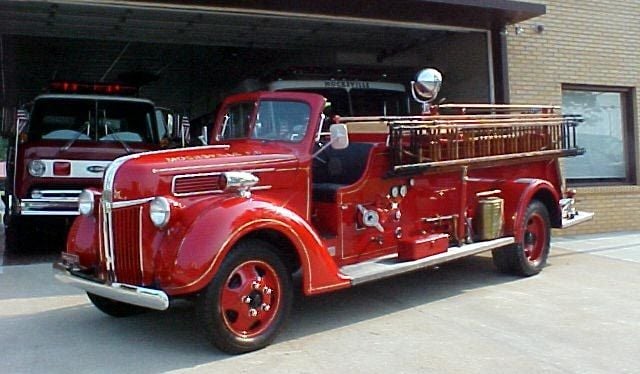Fire Truck History and Modern Lighting

Today, sirens and lights alert drivers to the presence and location of an emergency vehicle on the road. These audible and visual alarms signal other cars to move to the left or right and clear a path for first responders to facilitate speedy arrival to the site of an accident or other emergency. America firefighting has come a long way from rather humble beginnings.
Background history on American fire trucks
The law in America prior to the development of the fire department was for any home featuring a hearth to keep a bucket of water on-hand. Fortunately, founding father Benjamin Franklin organized the first emergency fire company in 1737.
Original fire engines were large water tanks on horse drawn wagons which were operated by hand to pump water out of a long, malleable spigot. Several men would use brute strength to create a strong stream of water by pumping long levers on either side of the tank to mechanically expel the water.
By 1905, the use of a motorized fire engine was proposed by Popular Mechanics (the same organization who produces the magazine with which we are familiar today). The first fire truck was manufactured in Springfield, Massachusetts by the Knox Automobile Company in 1906. This prototype included ladders, lanterns, sirens, etc. Firefighters would stand on the running boards, holding tightly to the side of the truck as the vehicle wove through the streets to the site of the fire.
Modern firefighters and lighting necessities
The fire department servicing modern society does more than put out house fires or climb trees to rescue frightened cats. The lights on the fire engines of the modern age must both alert others to their presence and assist in life-saving work. Focused light on a road surface is needed to clean a hazardous waste spill or to illuminate an isolated area on a car in order to use specialized equipment to rescue passengers from a car wreck. Firefighters are trained to handle air-bag deployments and potential explosions. Multi-functional warning lights provide illumination where it is needed in order for firefighters to perform their work efficiently.
Types of lights on fire engines
It is critical for firefighters to have reliable, long-lasting LEDs which provide a focused, clear stream of bright light to enhance visibility of a dangerous area. This is particularly important if an accident occurs at night.
For a vehicle the size of a fire truck racing through the streets on its way to an emergency, strobing lights are essential. Lights are available in numerous strobing patterns which can alternate or synchronize creating a noticeable, far-reaching display for other motorists. Other lights to assist with visibility enhancement include visor, head and tail lights, surface lights, deck and dash lights, and roof mounted light bars. The mounting of several full-size light bars around the perimeter of the large cab of a fire engine is a common configuration. Mounts on the back and sides create a full circle of bright light around the truck.
Laws on color and lighting for fire trucks
Red and white lights are most widely used for fire engines and other fire department vehicles. Occasionally, some fire engines also display a blue fire light on the back of the truck. Each state in America has its own regulations on legal use of color and light installation sites. Many states go so far as to mandate how lights may be used coming to and departing from the site of an emergency. If you are a volunteer firefighter wishing to mount emergency lighting on your personal vehicle, be certain to educate yourself on the laws in your state to avoid violation of state mandated regulations.
LED technology is the way of modern fire truck lighting
For a modern world with complicated scenarios and more opportunities for life threatening accidents at any time of day, the best lighting available is the focused, bright beams of LED lights. With more obstacles like distracting traffic lights, hundreds of other cars, and hazardous materials, visibility can mean the difference between efficient work or increased danger.



 Facebook
Facebook
 Twitter
Twitter
 Instagram
Instagram
 Youtube
Youtube





